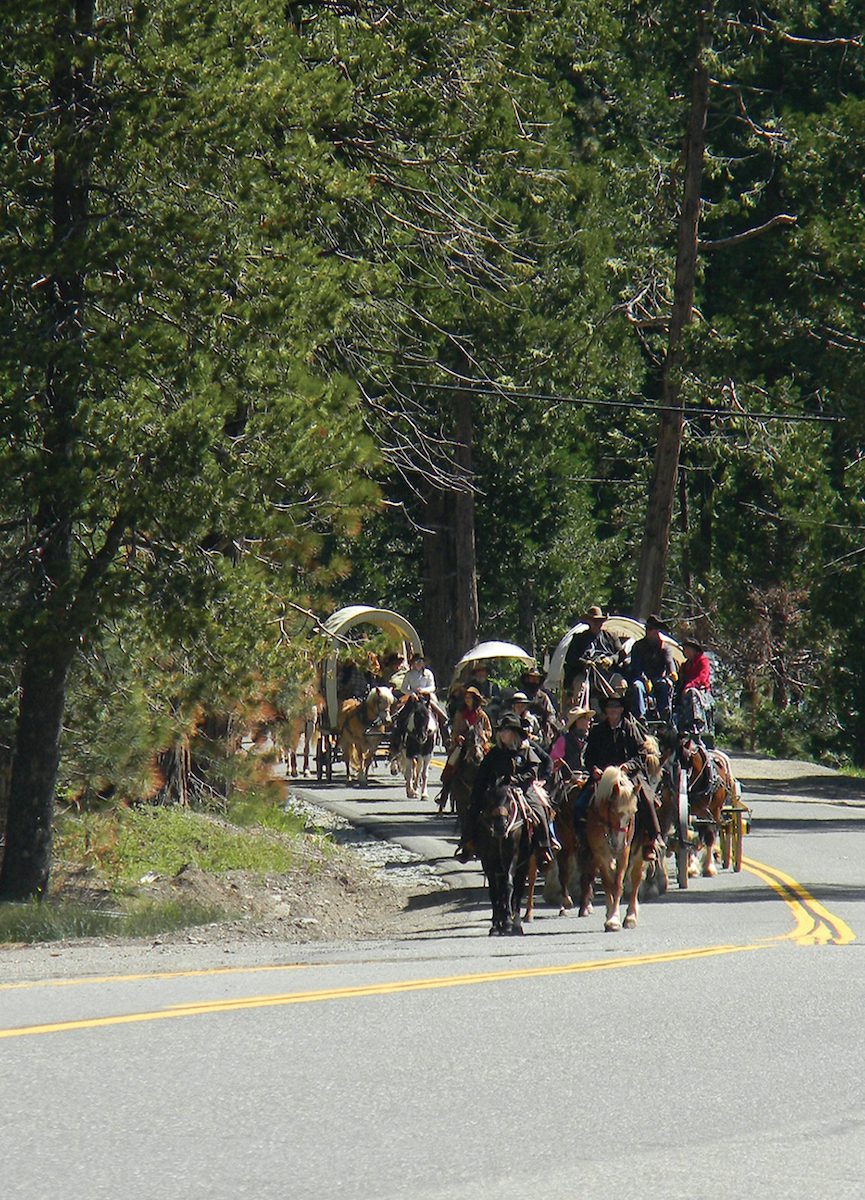
02 May History on a Roll
The annual Highway 50 Association reenactment of the Great Westward Migration draws horse lovers and history buffs working to keep the tradition alive
Settlers in horse-drawn wagons once crossed the Sierra Nevada in search of a better tomorrow, lured by the glow of gold on the horizon. The mineral may not be magnetic, but it still managed to exert a pull on the rest of the country and world, famously bringing hundreds of thousands of eager treasure-seekers to California starting in 1849.
While some pioneers journeyed through Panama and arrived in San Francisco, many chose to travel overland, trekking over what is now Echo Summit. As an alternative to the Truckee Route, the Carson Trail was still grueling but considered easier. It became so popular it earned the nickname the “Roaring Road” due to the noise created by lines of wagons filled with forty-niners excited about their impending riches.
Now, people still load their wagons to follow that same path over the Sierra, but these modern travelers are in search of a better yesterday—one free of the glow of pocket-sized screens and the unique stresses of life in the twenty-first century.
‘A New Way to See the Mountainside’
Welcome to the Highway 50 Association Wagon Train, an annual commemoration of the Great Western Migration from Lake Tahoe to Placerville, taking place from May 31 to June 7. First staged in 1949 to mark the Gold Rush centennial, this event has since become a late-spring staple for anyone whose heart beats in time with the clip-clop of draft horses.
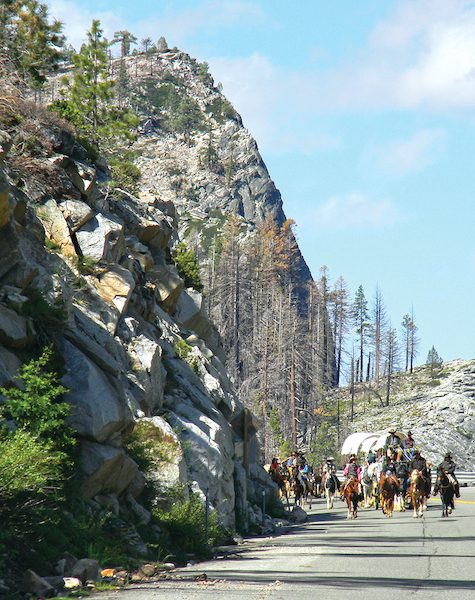
Rolling down Echo Summit into Twin Bridges
Steve Downer—president of the board, wagon master, owner of Silver Spur Carriage Company and 17-year veteran of the wagon train—explains that participants ride “right in the lane of Highway 50. We have law enforcement that moves traffic around us. We take breaks, pull over, let traffic clear out, rest the horses. If you’re driving out that day, you will run across us.”
He says the wagons cover anywhere from 10 to 15 miles a day. Traveling at roughly 3 miles per hour, even those who have driven over Highway 50 countless times are treated to a completely different perspective of the rugged landscape.
“It’s a new way to see the mountainside,” says Downer.
Downer, who lives in the Lodi area, notes that the train can accommodate up to 14 wagons, but they generally get about 10 each year. Anyone can sign up for a seat, with some participants joining for just a day or two and others sticking with the whole eight days. Some people stay in hotels at night, while others roll out bedding under the stars. Some bring their own food, while others pay to enjoy meals made by a caterer who travels with the train.
“We do get a mix of people: young people still in school, middle-age working people, retired people,” Downer says. “All age groups do it.”
That said, the regulars encourage participation from the “younger generation,” mainly because many of the longtime teamsters—responsible for driving the wagons, including harnessing the horses—no longer have the energy to handle the eight-day event.
Rekindling the Fire
In other words, this history-focused moving campout is something of a historical object itself—and that’s something its diehard fans want to both capitalize on and push back against. Honoring the longtime legacy of the wagon train is important, but so is invigorating it with fresh faces.
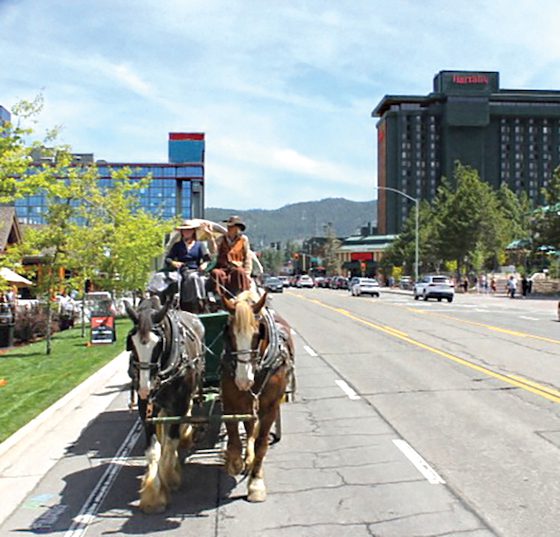
Passing the casino corridor in Stateline en route to Placerville at the start of last year’s event
“We’ve forgotten our roots here,” says Carol Spreckelsen Foster, an “outrider” who’s been with the train “on and off” for 34 years—sometimes in full buckskin regalia. The South Lake Tahoe resident has been seeking sponsors for various wagons and selling ads for a magazine the train distributes each year, but she hopes the Tahoe side of the ride will step up a bit more.
Foster explains that the Highway 50 Association started in 1951, and the nonprofit would get local businesses to sponsor wagons, paying for the teamsters bringing up the horses, shoeing them, feeding the animals and covering the required road insurance.
“In the early ’80s, this town supported Highway 50,” Foster says. “Casinos supported us.”
She says the actors from Gunsmoke and Bonanza came out to participate. John Wayne made an appearance. Locals partied for days in Round Hill, taking over a large grassy area that’s now Washoe Meadows State Park.
“It used to be a heckuva fun time,” Foster says. “It was fun, it was living history, it was enjoying the past, it was enjoying where you live—being happy with where you are and how important Highway 50 was. … I think we should celebrate this road more than we do.”
Now, her goal is to kindle that fire again: “I want to get people more involved. I want to say, ‘Hey, this is our history. It’s important we remember this.’”
Living History
Cecelia Smith remembers. Her mom took her to see the wagon train in 1989, and her first full trip was in 1990.
“It was like we were accepted into a new family,” she says.
Now a teamster based out of Yerington, Nevada, Smith says the welcoming she received as a horse-crazy 11-year-old of recently divorced parents changed her life.
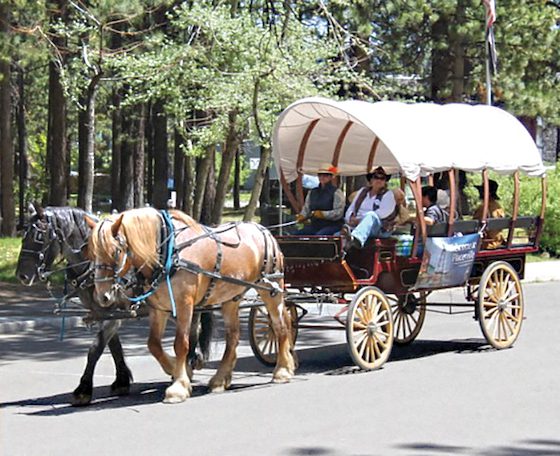
Jerusha McRoberts and Trish Ramos travel along the Pony Express Trail in Pollock Pines during the 2024 Highway 50 Association Wagon Train
“I was the type of kid that would follow anybody that had a horse around with a manure fork in one hand and brush in the other, just begging to help,” says Smith. “On a wagon train, there’s lots of people who need help.”
Smith now regularly provides help of her own, running a therapeutic horsemanship program for young girls who are victims of human trafficking. Horses are still a significant part of her life, as is the wagon train.
“It’s just harder and harder to keep it going,” she says, echoing Foster. “Less sponsors and less support from the community makes it really hard. … All those little girls. I don’t want it to ever die.”
Jerusha McRoberts is another teamster who first joined at a young age. When she was 3 months old, her mother strapped her into “a papoose sling” and rode her horse in the wagon train parade as it rolled through Pollock Pines. The 2025 ride will mark her 25th year participating—15 years in the saddle riding along with the wagons and another 10 driving. She started with a single horse and cart and worked up to a team of draft horses. McRoberts is now a hired teamster, with the wagon train being one of the jobs on her commercial carriage company calendar.
“People ask me why we do this,” McRoberts says. “We all take a week off of our regular jobs to go on vacation, and it’s a vacation that physically kicks your butt. It’s no toes-in-the-sand vacation, but we all keep doing it. We all get asked why. … I think the answer for me is that I don’t want it to go away, and if I have the ability to perpetuate it and educate someone else in it, that, then, is my responsibility and legacy.”
Smith echoes that sentiment in her own explanation of what brings her back year after year:
“It’s hard. It’s expensive. It’s nine days out of work to run yourself ragged,” she says. “I’ve asked myself that question almost every year at some point. Then, going down the road, in the crowd somewhere, there’s a little girl just looking up in awe. Her eyes sparkle, just amazed.
“Every year I see those eyes. It’s one thing for our kids to read about history—or nowadays click on the computer—and it’s another thing to feel it, hear it, see it going down the road right in front of them and to be able to reach out and touch it.”
Ryan Miller is a Sacramento-area writer and editor. Follow him on Instagram or X, @jesteram.
Highway 50 Association Wagon Train
When: May 31–June 7
What: 76th Reenactment of the Great Westward Migration
Where: Round Hill to Placerville
How to Participate: Register at hwy50wagontrain.com



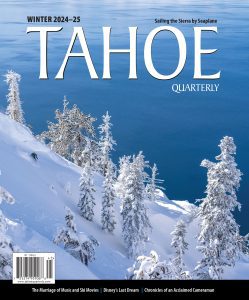
No Comments